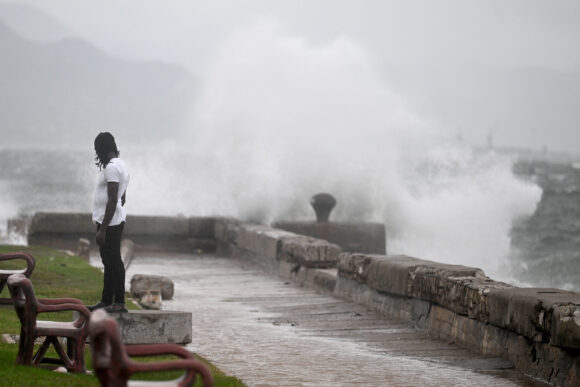Hurricane Melissa is churning toward Jamaica as the island’s worst-ever storm, with high winds and flooding rains already pummeling coastal areas in the hours before landfall.
Melissa’s top winds reached 185 miles (298 kilometers) per hour, up from 180 mph earlier Tuesday. It’s a Category 5 storm, the highest level on the five-step Saffir-Simpson scale. The dangerous storm was about 30 miles southeast of Negril, Jamaica, at the western tip of the island, the US National Hurricane Center said in an update at noon New York time.
If the storm maintains this intensity, it will be the strongest to hit in the Atlantic since Hurricane Dorian slammed into the Bahamas also with 185-mph winds, said Phil Klotzbach, a hurricane researcher at Colorado State University.
Meteorological Service of Jamaica Director Evan Thompson said the hurricane may make landfall soon. If it maintains its strength, Melissa would be the first confirmed Category 5 storm to hit Jamaica.
“It will cause catastrophic damage, life-threatening damage. There is very little that can stop a Category 5 hurricane,” Thompson said.
The hurricane center advised residents to take shelter in the most interior part of their homes, away from windows that could shatter if struck by debris. “You can cover yourself with a mattress and wear a helmet for added protection,” forecaster Larry Kelly wrote in an update.
Officials say that more than 6,000 people are now taking refuge in 382 of the 800 shelters that have been opened. There are about 25,000 tourists in the country as well.
Buildings where Melissa comes ashore may be completely destroyed, according to the hurricane center.
The hurricane is forecast to dump as much as 40 inches (102 centimeters) of rain across parts of Jamaica, and Melissa also threatens to push a wall of water of up to 13 feet into the coastline where it comes ashore. About half of all hurricane deaths come from drowning.
Prime Minister Andrew Holness said in a video statement posted on Monday that residents in low-lying and flood-prone areas should be prepared to flee given the high risk of “complete displacement and loss of life.”
Energy Minister Daryl Vaz said about 240,000 people, or 35% of the island’s clients, have lost power, largely in the west. In addition, 26% of mobile networks are now offline.
The government is hopeful that there will not be serious damage at Norman Manley International Airport in Kingston. If all goes as planned, clean up crews will be working Wednesday and the country’s main airport can begin receiving relief flights as soon as Thursday.
PetroJam has two to three weeks of aviation fuel stored, “so we will be able to accommodate relief flights,” Vaz said.
The fate of the airport at Montego Bay remains in doubt, as it’s expected to receive at least Category 3 winds. “We know that it could have potentially disabling impact on that airport,” he said.
Melissa has already led to at least seven deaths across the Caribbean, including three in Haiti. The storm is endangering roughly 3.5 million people across the region, according to estimates from the United Nations’ and European Union’s Global Disaster Alert and Coordination System.
Melissa is forecast to hit Cuba next and then rip through the Bahamas later this week.
Cuban President Miguel Diaz-Canel told his cabinet on Monday to “spare no expense” when it comes to making preparations ahead of Melissa’s landfall, despite an ongoing economic crisis that has resulted in shortages of food, medicine and basic goods.
Melissa’s compact size and western landfall in Jamaica means losses will likely fall short of early estimates that went as high as $16 billion, said Chuck Watson, a disaster modeler with Enki Research. He now estimates losses will reach $6.5 billion, comparable to the impact of Hurricane Gilbert in 1988.
Jamaica’s ports have been closed to shipping, according to the national port authority, and the state broadcaster reported the island’s international airports both halted operations over the weekend. Officials have ordered evacuations in more than a half dozen towns and cities, including Port Royal at the entrance to Kingston Harbor, which dates back to the 17th century.
- Update: Catastrophe Bond Investors Told to Brace for Jamaica Payout
- Update: Hurricane Melissa Churns Toward Jamaica as Category 5 Storm
Was this article valuable?
Here are more articles you may enjoy.



 Viewpoint: Agentic AI Is Coming to Insurance Industry – Much Faster Than You Think
Viewpoint: Agentic AI Is Coming to Insurance Industry – Much Faster Than You Think  Dunkin’ Cashier in Georgia, Stabbed by Rapper, Can’t Claim More Than Workers’ Comp
Dunkin’ Cashier in Georgia, Stabbed by Rapper, Can’t Claim More Than Workers’ Comp  Pierce Named CEO of GEICO as Combs Resigns
Pierce Named CEO of GEICO as Combs Resigns  Lawsuit Over Burger King’s Whopper Ads Set Back by Federal Judge
Lawsuit Over Burger King’s Whopper Ads Set Back by Federal Judge 

